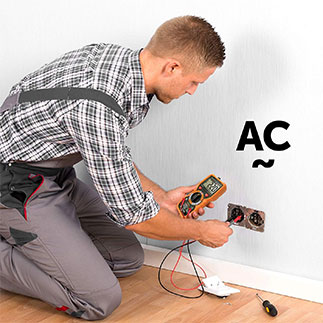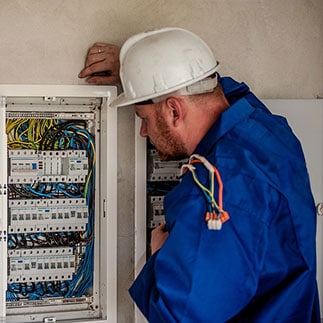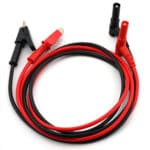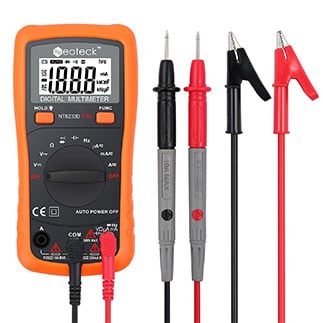A multimeter is a helpful device used to measure voltage, electricity, resistance, etc. It is a device most household should have, and most handymen do have. It makes repairs and other jobs easier. You can use a multimeter to measure AC voltage. We have provided you with some helpful information regarding this issue.
Using a Multimeter For Beginners
Using a multimeter is easier if you have at least some information on what it is and how it works. The main parts of this device are the display, the dial, and the ports, probes or leads.
The display will naturally display the measurements you require in digits. The result will usually consist of four numbers. When something goes wrong, the screen will often show a negative result. Depending on the model you purchase, the display could have an option of remaining light even in the dark.
The dial or the selection knob is used to set it for particular readings. In some cases, you will want to measure voltage and in others resistance. Either way, this is what the dial is used for.
The ports are used to connect to devices or systems. Usually, all multimeters will have two probes – a red one and a black one.
How to Properly Measure Voltage
To measure voltage, you don’t need a lot of specialized knowledge or equipment. You can try out on a battery. All you’ll need to do it is to connect the test leads with the multimeter accordingly. If the connection isn’t good enough, you’ll be able to notice since the result will be negative. Many people wonder how to use a multimeter to test AC voltage. It is not as difficult as it sounds. The trick is to follow the right colors or signifiers and connect the leads correctly.
Measuring AC Voltage
 First off, you’ll need to know what range of voltage you are dealing with. If you do not know that, then set the range on your multimeter to the highest voltage and turn the dial to ṽ. Make sure your multimeter is not set on the auto-range mode. That will not help you get the accurate measurements.
First off, you’ll need to know what range of voltage you are dealing with. If you do not know that, then set the range on your multimeter to the highest voltage and turn the dial to ṽ. Make sure your multimeter is not set on the auto-range mode. That will not help you get the accurate measurements.
Next, you’ll need to connect the black lead with the jack “COM.” Then you need to connect the red lead. It will go in the VΩ jack. When you wish to remove the points leads remember to start by disconnecting the red first, and the black second. Try not to touch the tips of the leads with your fingers.
The following step is to read what you get on your display. The display should give you the results quickly. If you want to note a measurement without having to write it down, immediately press the Hold button. You will know if the reading is completed because there will be a beeping sound.
Not sure which multimeter is perfect for your AC? Check out our top picks used specifically for HVAC systems here.
The Most Common Mistakes
The most common mistake is mixing up the leads and putting them in the wrong places. That can cause damage to the AC system. What is worse, it can injure you. Though this rarely happens, it is better to keep yourself and your home safe.
How to Read the Measurements
All AC voltage measurements will inevitably vary. It will depend on how the power is distributed, or in other words the source of voltage. It can also depend on the type of AC system. You need to take into consideration the fact that if you measure the AC voltage at different times, the result will also vary.
What usually happens is that the voltage is lower than what is expected or regarded as standard.
 Be Careful At All Times
Be Careful At All Times
Safety measures are something people tend to neglect. You should never underestimate what damage can occur when you operate your AC or any other device. Precautions must be followed at all times.
One of the most important things to remember is how to handle probes. Never try to touch the tips of the probes. Remember to place the probes in the right positions. Pay attention to the regulator and see if it’s placed in the accurate position.
As mentioned before, remember to remove the leads or the probes in the right order. Take out the red one first and black one second.
Extra tip: Never forget to wear gloves, goggles, and special shoes for extra safety precautions.
The Ports, Probes or Leads
The parts of the multimeter are probably the most important. They are made out of top-notch materials to give better readings and last longer. If they are not made from the proper materials, they will sometimes show inaccurate results making your job more difficult. If the device isn’t put together right, it can even lead to electrocution.
That is why you need to do your research before buying a multimeter. You need to know which materials you will be using it on, and what type of probes will it require. Doing the research will help you avoid errors, damage, and will save you from unnecessary expenses.
 Inspect Leads
Inspect Leads
Once you’ve already done your research and you know what your multimeter and its leads are good for, you can carry on. The next step is to inspect the leads visually. If there is no other potential risk, the only remaining inspection is to see whether there is visible damage or malfunction. What you are looking for are possible cracks, melted parts, darkened parts, or disconnected parts. If not you may continue with the process.
The Final Step – Testing the Leads
The final step is to test the leads. That can be done by putting your multimeter into resistance mode for which the value is in ohms. Next, you will connect the points to the device and touch the tips of the leads. If everything goes according to plan, the reading should be 0.5 ohms or lower. It is essential to do conduct these tests beforehand. This way you can get an accurate reading, avoid damage, or possible injuries.
The post Learn How to Use A Multimeter to Test AC Voltage appeared first on Tool Nerds.
from Tool Nerds https://ift.tt/2Dn6eXx
via IFTTT

No comments:
Post a Comment